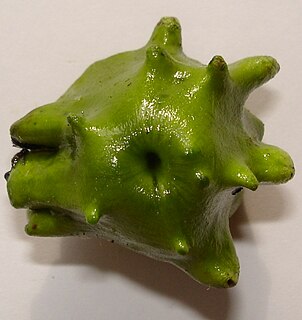Related Research Articles

Quercus cerris, the Turkey oak or Austrian oak, is an oak native to south-eastern Europe and Asia Minor. It is the type species of Quercus sect. Cerris, a section of the genus characterised by shoot buds surrounded by soft bristles, bristle-tipped leaf lobes, and acorns that usually mature in 18 months.

Oak apple or oak gall is the common name for a large, round, vaguely apple-like gall commonly found on many species of oak. Oak apples range in size from 2 to 4 centimetres in diameter and are caused by chemicals injected by the larva of certain kinds of gall wasp in the family Cynipidae. The adult female wasp lays single eggs in developing leaf buds. The wasp larvae feed on the gall tissue resulting from their secretions, which modify the oak bud into the gall, a structure that protects the developing larvae until they undergo metamorphosis into adults.

Andricus quercuscalicis is a gall wasp species inducing knopper galls.

The common spangle gall on the underside of leaves and the currant gall on the male catkins or occasionally the leaves, develop as chemically induced distortions on pedunculate oak, or sessile oak trees, caused by the cynipid wasp Neuroterus quercusbaccarum which has both agamic and bisexual generations.

Andricus grossulariae is a gall wasp species inducing agamic acorn cup galls on oak tree acorn cups and sexual phase galls on catkins. Synonyms include Andricus fructuum, Andricus gemellus, Andricus intermedius, Andricus mayri and Cynips panteli.

Andricus dentimitratus is a gall forming wasp in the genus Andricus. The adults lay their eggs on various species of oak and the developing larvae causes the trees to create a large ornate gall. The oaks parasitised include Quercus frainetto, Q. petraea, Q. pyrenaica, Q. pubescens and Q. robur. The gall is formed out of the cup of the acorn. In cross-section it resembles a mushroom. It is woody, maroon, shiny and sticky. It grows up to 25 mm high and 20 mm wide. What resembles the head of the mushroom is lobed or toothed in various ways. The insect emerges from the narrowing, between the head and base.

Andricus quercuscalifornicus, or the California gall wasp, is a small wasp species that induces oak apple galls on white oaks, primarily the Valley Oak but also other species such as Quercus berberidifolia. It is found from Washington, Oregon, and California to northern regions of Mexico. Often multiple wasps in different life stages occupy the same gall.

Andricus aries is a species of gall-forming wasps, in the genus Andricus. The species was named by the French entomologist Joseph-Étienne Giraud, in 1859. It is commonly found in eastern Europe and during the 21st century has spread to western Europe.
Pseudoneuroterus mazandarani is a gall wasp species in the family Cynipidae whose life cycle involves only Palaearctic oaks, Quercus subgen. Quercus, in the section Cerris.
Dryocosmus jungalii is a gall wasp species in the family Cynipidae whose life cycle involves only Palaearctic oaks, Quercus subgen. Quercus, in the section Cerris.

Trichagalma formosana is a gall wasp species in the family Cynipidae whose life cycle involves only Palaearctic oaks, Quercus subgen. Quercus, in the section Cerris. It is endemic to Taiwan.
Aphelonyx kordestanica is a gall wasp species in the family Cynipidae whose life cycle involves only Palaearctic oaks, Quercus subgen. Quercus, in the section Cerris.
Aphelonyx is a genus of oak gall wasps in the family Cynipidae, comprising three known species:
Synergini is a tribe of tropical gall wasps in the subfamily Cynipinae.

Andricus kingi, the red cone gall wasp, is a species of gall wasp in the family Cynipidae.
Andricus infectorius is a species of gall-forming wasp. The species was named by the German biologist Theodor Hartig, in 1843 and is found in Europe.
Andricus mukaigawae is a species of gall wasp native to southeastern Asia. It creates galls on the buds and leaves of oak trees. The galls are sometimes used by other gall wasps unable to create galls of their own, with both species sharing the gall.

Andricus dimorphus, also called the clustered midrib gall wasp, is a species of oak gall wasp in the family Cynipidae. Galls in which the larvae live and feed are formed in clusters along the midrib on the underside of oak leaves.
Synergus japonicus is a species of gall wasp in the family Cynipidae. Whereas most gall wasps create the galls in which they live, Synergus japonicus is an inquiline species, living in the gall created by another species of wasp. It is native to Japan, China and Russia.

Andricus quercuspetiolicola, also called the oak petiole gall wasp, is a species of oak gall wasp in the family Cynipidae. Galls in which the larvae live and feed are formed along the midrib or petiole of white oak leaves.
References
- 1 2 Melika G, Pujade-Villar J, Abe Y, Tang CT, Nicholls J, Wachi N, Ide T, Yang MM, Penzes Z, Gyorgy C, Stone GN (2010). "Palaearctic oak gallwasps galling oaks (Quercus) in the section Cerris: re-appraisal of generic limits, with descriptions of new genera and species (Hymenoptera: Cynipidae: Cynipini)" (PDF). Zootaxa. 2470: 1–79.
| | This Apocrita-related article is a stub. You can help Wikipedia by expanding it. |